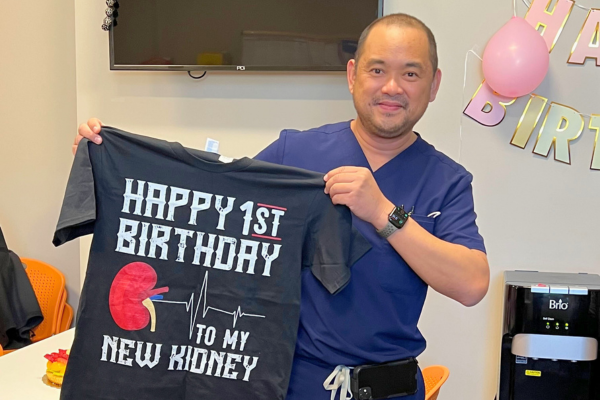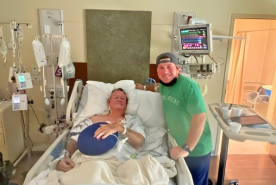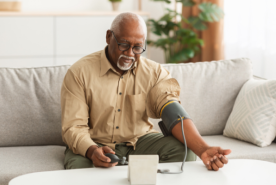August 12, 2025
Learn how Patrick faced 10 years of dialysis for IgA nephropathy, received a transplant, and now inspires other kidney patients to find hope and purpose.
When Patrick experienced sudden foot pain, he never imagined it would lead to a diagnosis of IgA nephropathy, a serious form of chronic kidney disease. After years of peritoneal dialysis, he finally received a kidney transplant. Now, he's helping others on their kidney journey.
IgA Nephropathy Diagnosis After a Gout Attack

In 2011, Patrick lived in San Francisco, where he worked as a real estate investor, when he experienced sudden pain in his foot.
“I couldn’t even walk from my room to the bathroom,” Patrick said. “It was that bad.”
Patrick went to the emergency room for help. Instead of answers, he was told to change his shoes.
“It didn’t sit right with me,” he said. “I got a second opinion.”
The new doctor told Patrick he had gout, a type of arthritis caused by excess uric acid. Kidneys usually remove uric acid. When too much builds up, it can form sharp crystals in the joints, causing sudden pain, swelling, and redness.
“I received bloodwork and scheduled a follow-up to discuss any findings,” Patrick said. “I didn’t expect them to call me back a few days later to tell me my kidneys were failing.”
Diagnosed with IgA Nephropathy
Soon after the kidney failure diagnosis, Patrick got a kidney biopsy to determine the cause.
“They diagnosed me with IgA nephropathy or IgAN,” he said. “My kidneys were only functioning at 19% when they caught it.”
What Is IgA?
IgA is a protein made by the immune system that helps fight off infections. Too much IgA in the kidneys can cause inflammation or swelling.
What Is IgA Nephropathy?
IgA nephropathy (IgAN) is a type of chronic kidney disease. It occurs when an antibody called immunoglobulin A (IgA) builds up in the kidneys.
How IgAN Affects the Kidneys
Inflammation can damage the glomeruli, tiny filters in the kidneys. If not caught early enough, the damage can cause kidney disease.
When Patrick was diagnosed, there were no FDA-approved treatments specifically for IgAN.
“There was no saving my kidneys at that point,” Patrick said. “My nephrologist told me I needed to start dialysis.”
Thankfully, IgAN treatments have since been developed, offering new hope to people with IgAN.
FDA-approved treatments include:
- Tarpeyo (budesonide): A steroid that helps lower inflammation in the area of the gut where IgAN may start. It lowers the amount of protein in urine, a key sign of kidney damage.
- Nefecon (a delayed-release form of budesonide): A delayed-release version of Tarpeyo approved to slow kidney damage in people with IgAN.
- Filspari (sparsentan): Relaxes blood vessels in the kidneys and reduces stress on them.
These treatments don’t cure IgAN, but they can slow the damage, especially if started early. Your healthcare provider can help decide if one of these is right for you.
Dialysis Delays and a Life-Threatening Coma
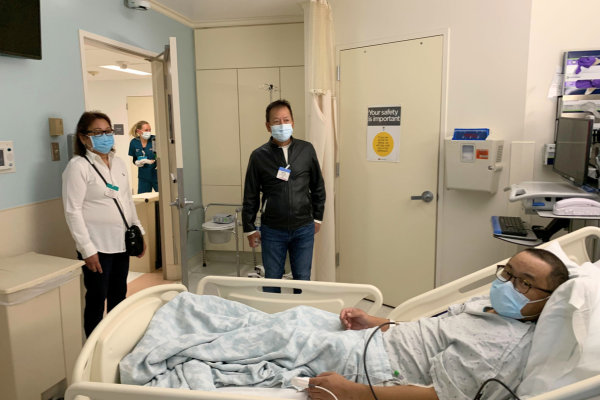
Patrick chose peritoneal dialysis (PD), a home dialysis option that uses the natural lining of the abdomen and a catheter to clean blood.
“I wasn’t properly educated, and I was in denial about needing dialysis,” he said. “I needed a catheter to start, but I was hesitant to schedule the surgery.”
Despite worsening symptoms like shortness of breath and fluid buildup, Patrick continued to delay treatment.
“I thought I could just walk in and start dialysis the next day when I was ready,” Patrick said. “But it doesn’t work like that.”
Patrick finally scheduled the catheter surgery when he couldn’t sleep properly due to fluid build-up.
“I didn’t wake up after the surgery,” he said. “My blood was so toxic, and I didn’t handle the anesthesia well. I ended up coding. They placed me in a medically induced coma.”
Patrick woke up three days later in the intensive care unit (ICU). He had an emergency dialysis access line in his groin and was intubated.
“It was terrifying. I didn’t realize how serious kidney failure was until then,” he said. “I was scared.”
Watch videos by patients to learn about your treatment options.
Join the NKF Blog Newsletter
Get Support, Delivered Monthly
Get monthly inspirational stories, practical insights, and expert advice to manage your kidney health at any stage.
Starting PD
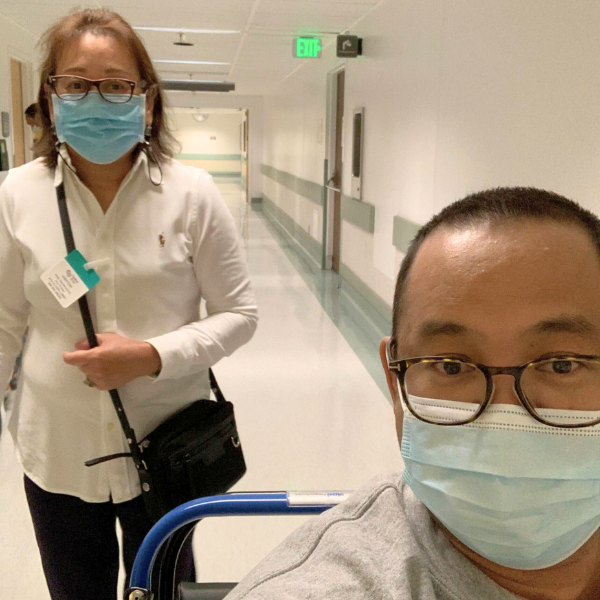
With his family by his side, Patrick spent two weeks in the intensive care unit receiving hemodialysis through his emergency port.
“I continued in-center hemodialysis once I got home from the hospital,” he said. “My PD catheter still needed time to heal.”
For three months, Patrick did hemodialysis three times a week for three hours each session. He got approved for the kidney transplant waitlist and started training for PD.
“I trained for three weeks. They showed me how to use the equipment,” Patrick said, “But they didn’t explain why I was doing it. I still didn’t understand my disease.”
New to kidney disease? Talk with a trained mentor who understands. Sign up for NKF Peers.
Dealing with Depression
Patrick was used to a fast-paced lifestyle. He loved his job and enjoyed fine dining and racing the cars and motorcycles he collected. He had to leave all that behind when he got sick.
“I had to move in with my parents,” Patrick said. “I was depressed, lost, and lonely.”
Then, just a year after his kidneys failed, Patrick was also diagnosed with heart failure.
“Doctors thought I’d need a heart and kidney transplant,” he said. “I was barely into my thirties, and I was already so sick. I didn’t know if there was a future for me.”
Patrick’s heart failure was caused by dehydration from dialysis. The dehydration caused his heart to pump faster, which enlarged the muscle.
“I was always short of breath and had to wear a life vest, a portable defibrillator I carried 24/7,” Patrick said. “But, thanks to the right medication, my heart function improved.”
It took Patrick a few years, but he learned more about kidney disease, accepted his diagnosis, and fell into his dialysis routine–always with the hope of a kidney transplant.
“PD is the closest thing to having a kidney because you do it every day. It was a smoother experience that helped me feel better,” he said. “I slowly got back into my hobbies. I also met, fell in love with, and married my wife.”
A Kidney Transplant After a Decade of Dialysis
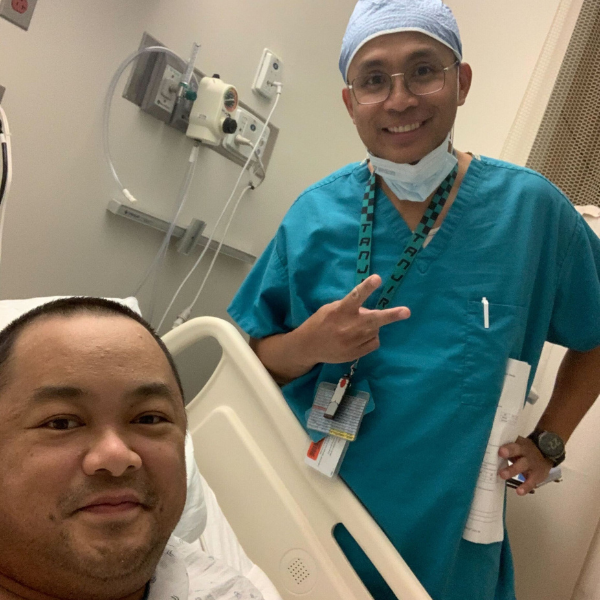
Patrick spent 10 and a half years on PD before he received the first transplant call.
“I received four transplant offers in two months,” Patrick said. “Three didn’t work out. The fourth was the charm.”
Despite the excitement, Patrick hesitated.
“My donor was deceased. They passed away in a car accident. I felt guilty that someone had to die for me to live,” he said. “I was also used to dialysis. This was new.”
But Patrick had to make a decision. He didn’t have time to dwell on his fears.
“I went forward with the transplant surgery,” said Patrick. “It went well, but I continued to struggle with guilt.”
Once Patrick adjusted to his new normal, he decided that the best way to repay his donor was to live life to the fullest.
“My faith, family, and wife helped,” he said. “I don’t know what I would have done without them.”
Finding Purpose in Educating Others
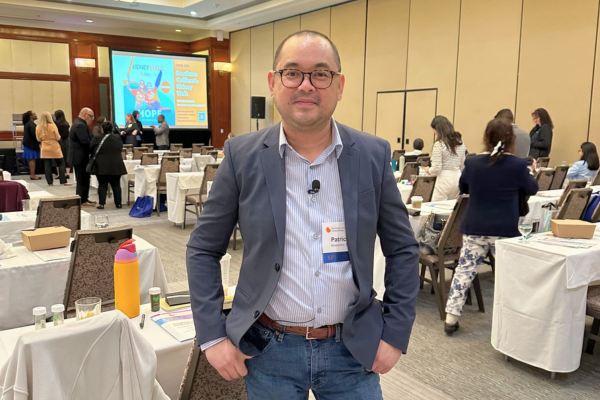
Shortly after Patrick's transplant, he got a call from the dialysis unit that trained him, offering him a job as a Regional Dialysis Modality Specialist.
“I was in contact with this office for years. They helped me with my PD journey and were thrilled to hear I got a transplant,” he said. “I happily accepted the position.”
Now, Patrick educates people about their dialysis options–especially home dialysis.
“They’re lost,” he said. “Once I talk to them, share my story, and educate them, they feel more settled. The more you know, the easier it is to accept what’s happening. What’s scary is not knowing.”
Education is at the heart of Patrick’s message, but he also encourages people facing dialysis to advocate for themselves and build relationships with their care team.
“Dialysis isn’t the end. It’s a bridge to get to your goal,” Patrick explained, “And the goal is always transplant.”
Looking back on how far he’s come, Patrick is proud of the person he is today.
“If someone asked me if I’d do it all over again to be the person I am now, I’d honestly say yes,” he said. “I love myself more now because I have a purpose.”
Is home dialysis right for you? Take our quick quiz to find out.
